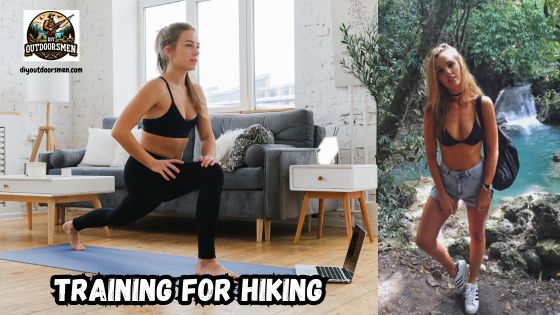Contents
- 1 Key Areas to Focus on When Preparing for a Long-Distance Hike
- 2 Steps for Building a Solid Training Routine
- 3 Strength Training for Hiking
- 4 Cardio and Endurance Building
- 5 Practice Hiking in Terrain Similar to Your Goal
- 6 Other Considerations for Safe and Enjoyable Training
- 7 Popular Training Exercises for a Long-Distance Hike Explained
- 8 Frequently Asked Questions
- 9 The Essential Gear and RealWorld Prep
Taking on a long-distance hike is a rewarding challenge that pushes both my body and mind. Getting ready for miles of trails, changing weather, and heavy backpacks calls for more than just excitement.
QUICK LOOK: Training Exercises for a Long-Distance Hike
- Single-leg deadlifts: Strengthens my hamstrings and glutes, while improving balance and ankle stability, which I need for rocky sections.
- Heel and calf raises: Give my calves power for uphill climbs and help prevent cramping.
- Glute bridges: Activates key muscle groups for both climbing and maintaining posture with a heavy pack.
- Hip rolls: Helps with hip flexibility and stability, reducing the risk of hip or lower back pain after long days.
- Lunges and step-ups: Improve dynamic balance and directly mimic the motion of big trail steps or logs. They also strengthen quads, glutes, and hamstrings.
- Squats: I do bodyweight squats or add weights for extra challenge. These boost my thighs and glutes, which power me uphill and steady me during descents.
- Regular walking: I start with brisk walks around my neighborhood, then move to local parks or greenways to add more hills and distance.
- Hill workouts: Walking or jogging up and down hills builds both leg power and cardiovascular strength. Local staircases or treadmills with an incline setting work well if I don’t have hills nearby.
- Weighted vests or packed backpacks: Carrying weight mimics real trail conditions and quickly reveals my limits with extra gear. I begin with a light load, then slowly add more as my body adapts.
- Other cardio: I mix in cycling, swimming, or jogging for variety and extra aerobic fitness. These also ease the impact on my joints.
I know that building strength, endurance, and trail skills ahead of time helps me enjoy the experience and reach my goals safely and confidently. Here, I’ll walk you through an all-in-one guide on how I train for a long-distance hike, covering key exercises, planning strategies, and ways to get comfortable on the trail.
Key Areas to Focus on When Preparing for a Long-Distance Hike
Training my body for a major long-distance hike means focusing on three main areas: strength, endurance, and practicing hiking. All three of these work together to prepare me for the varied challenges of real trails.
I build leg and core muscle to carry myself over hills and rocks, work on endurance so I can hike for long stretches, and get in plenty of actual hiking practice so nothing surprises me when I’m out there. Hiking’s popularity keeps rising, with destinations like the Pacific Crest Trail or the Camino de Santiago attracting thousands every year.
I see plenty of guides and forums filled with advice from hikers who learned from experience about what works and what doesn’t. Many successful hikes come down to careful, monthslong preparation rather than natural athletic ability.
A trail can throw lots of surprises my way: steep climbs, rocky descents, river crossings, or even carrying extra weight in the rain. When my legs, core, and back are strong, and my lungs are conditioned for hours of movement, each mile feels much more manageable.
Steps for Building a Solid Training Routine
The most effective training routine for a long-distance hike is balanced and gradual. My plan always mixes these activities:
- Strength training: Builds up my legs, core, and upper body for stability and stamina.
- Endurance or cardio sessions: Prepares my heart and lungs for all-day activity.
- Practice hikes with a backpack: Gets my feet and mind used to real trail conditions and distances.
In the early weeks, I focus more on building a base. That means I walk regularly, hit the gym or do bodyweight exercises at home, and work on improving flexibility. As the hiking trip gets closer, I add more trail time and start wearing a packed backpack to mimic the real thing.
Strength Training for Hiking
Legs take most of the workload on a long-distance hike, but the rest of my body supports balance, posture, and backpack carrying. I make these exercises a priority:
- Squats: I do bodyweight squats or add weights for extra challenge. These boost my thighs and glutes, which power me uphill and steady me during descents.
- Lunges: Forward, backward, and side lunges all train different leg muscles and help with balance on uneven ground.
- Step-ups: By stepping up onto a bench or box, I strengthen climbing muscles. Carrying dumbbells or hiking with a loaded pack turns this into a real-life hiking drill.
- Single-leg deadlifts: This move targets hamstrings and glutes and helps me build ankle stability, which is super important on rocky paths.
- Heel raises: Strengthening calf muscles helps me on those long ascents and gives me power for rough terrain.
- Glute bridges and hip rolls: These two boost my core and hips, building better movement and stability over technical ground.
I include two to three strength-focused workouts a week. Sometimes, I use resistance bands or household objects if I don’t have access to a gym. Each session lasts about 3040 minutes. Focusing on good form, not just repetitions, makes a bigger difference for me.
Cardio and Endurance Building
Endurance training forms the backbone of my long-distance hike prep. My main goal is to be able to hike for hours without feeling winded or sore partway through. I gradually ramp up the time and challenge level of my workouts to avoid burnout or injury.
- Regular walking: I start with brisk walks around my neighborhood, then move to local parks or greenways to add more hills and distance.
- Hill workouts: Walking or jogging up and down hills builds both leg power and cardiovascular strength. Local staircases or treadmills with an incline setting work well if I don’t have hills nearby.
- Weighted vests or packed backpacks: Carrying weight mimics real trail conditions and quickly reveals my limits with extra gear. I begin with a light load, then slowly add more as my body adapts.
- Other cardio: I mix in cycling, swimming, or jogging for variety and extra aerobic fitness. These also ease the impact on my joints.
A simple weekly structure is two to three shorter sessions (30-60 minutes) with one longer session that increases in length every week. Following the “10% rule” for increasing duration or intensity helps prevent overuse injuries. If I hike four miles one weekend, the next weekend I aim for 4.5 miles or slightly more, not double or triple the distance.
Practice Hiking in Terrain Similar to Your Goal
Once I build some strength and stamina, I put it to use with real hikes on trails. Doing this on varied paths, rocky, muddy, sandy, or hilly, is way more helpful than sticking to flat sidewalks. These outings teach me how my gear feels, reveal foot problems early, and show where I might need more training.
- Simulate real conditions: I look for trails with similar elevation, surfaces, or challenges to my target hike. If the trail is known for long uphills or river crossings, I try to include that in my training runs.
- Build distance and elevation gradually: I start with what I can handle and slowly add distance or vertical gain. My goal is to work up to the toughest day I’ll face on the hike well before trip day.
- Practice carrying a backpack: Every couple of weeks, I hike with a little more weight so that a full pack doesn’t feel surprising. I also tinker with how I pack and organize to find what’s comfortable after a few hours.
During these hikes, I pay attention to pace, foot discomfort, hydration, and energy levels. Emergency snacks and a water bladder are always with me, even on training hikes, to build solid habits for the full trek. Including a few friends as hiking buddies is also a great way to stay motivated and safe in unfamiliar areas.
Other Considerations for Safe and Enjoyable Training
Physical training is only one part of my prep. There are several other details I think about to help prevent setbacks on a long-distance hike:
- Listen to my body: Rest days keep me from getting hurt or burned out. If something hurts more than usual, I take time off instead of pushing through it.
- Fuel up and hydrate: Eating balanced meals and drinking enough water supports my muscles and energy. I experiment with snacks, electrolytes, and meals on training hikes to see what works.
- Warmups and cooldowns: Spending 10 minutes before and after each session on light stretching or foam rolling helps my muscles recover and stay loose.
I also double-check my shoes and gear every few weeks. Worn-out hiking boots can make any hike miserable, so I break in new ones ahead of time and use the same socks and insoles on real hikes. Adding practices like yoga or Pilates can keep me limber, reduce muscle soreness, and improve my breathing as I prepare.
Popular Training Exercises for a Long-Distance Hike Explained
Some exercises work especially well for hiking. Here’s why I always include them and what they help with:
- Single-leg deadlifts: Strengthens my hamstrings and glutes, while improving balance and ankle stability, which I need for rocky sections.
- Heel and calf raises: Gives my calves power for uphill climbs and helps prevent cramping.
- Glute bridges: Activates key muscle groups for both climbing and maintaining posture with a heavy pack.
- Hip rolls: Helps with hip flexibility and stability, reducing the risk of hip or lower back pain after long days.
- Lunges and step-ups: Improve dynamic balance and directly mimic the motion of big trail steps or logs. They also strengthen quads, glutes, and hamstrings.
Mixing these moves with hill walking, stretching, and occasional hikes gives me a thorough, practical program that leaves me ready for almost anything a long-distance trail can throw at me. Including interval training or walking with hiking poles can further challenge my muscles and prepare me for real-world conditions.
Frequently Asked Questions
As I worked through my own hiking training, a few common questions came up. Here’s what I learned along the way:
How early do I need to start training before my hike?
For best results, I start at least three or four months ahead of the trip. Building fitness slowly keeps me on track and lessens the chance of injuries or burnout.
What are good snacks and meals for training hikes?
I use a mix of quick carbs like dried fruit, trail mix, or granola when I need a fast boost, along with nuts, nut butters, or wholegrain bars for steadier energy. Training is the time to learn what foods work for my body over several hours.
How do I prevent blisters before a long-distance hike?
I always break in my shoes, wear moisture-wicking socks, and use foot powder or antiblister tape in trouble spots on longer hikes. If I feel rubbing, I stop and fix the problem before it grows. Foot health is really important for multiday treks.
The Essential Gear and RealWorld Prep
Deciding what to put in my pack is another skill I practice while training. I found that the right footwear, layered clothes, a comfortable pack, and hydration systems make a world of difference. Swapping heavy items for lighter alternatives or testing gear setups on practice hikes helps me tweak before my actual trip.
For example, hiking poles saved my knees during descent practice, and a well-fitted pack with padded straps left my shoulders less sore after a full day outside.
- Footwear: I make sure my hiking boots or shoes are already broken in. Trying out new socks or footbeds ahead of time also helps me avoid mid-hike issues.
- Backpack: I adjust the straps, back panel, and hip belt until the whole pack feels secure but not restrictive. Practice hikes with the full load show me where I might get hot spots or pressure points.
- Clothing: Training in the clothes I’ll actually wear, rain jacket, quick-dry shirts, fleece layers, means I know exactly how each layer feels, even when sweaty or wet.
This hands-on gear prep combined with physical training puts me in a strong, confident position to enjoy every mile out there. Remember to rest, pay attention to your body’s signals, and look forward to the adventure ahead—every step you take is a step closer to your goal!
Most Recent Articles:
- Understanding Deer Behavior To Improve Your Hunt

- Complete Guide On Tracking Game Animals

- DIY 4-Step Guide To Field Dressing And Quartering A Deer

- Night Vision Binoculars For Nocturnal Hunting

- The Science Behind Camouflage Patterns For Deer Hunting

- Binocular Accessories For Hunters

As always, stay safe, enjoy the journey, and please try to leave it cleaner than you found it. If you have any comments, questions, ideas, or suggestions, please leave them in the comment section below, and I’ll get back to you ASAP. You can follow us on YouTube: Man Art Creations for videos of our DIY Adventures.
P.S. Thanks so much for checking out our blog; we really appreciate it. Just so you know, we may receive a commission if you click on some of the links that appear on our site. This helps us keep our content free and up-to-date for everyone. We appreciate your support!



